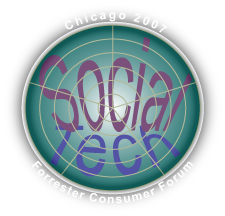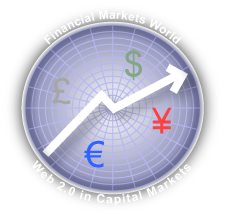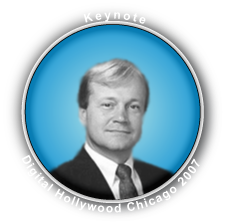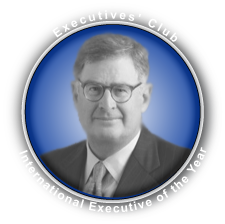… Risky, Loaded and Ready to Help You Improve Your Business
 The Global Human Capital Journal’s coverage of the Forrester Consumer Forum 2007 continues with this session on the disruptive power of customers’ Web 2.0 activity. Charlene Li, Vice President and Principal Analyst, Forrester Research, briefed the conference on the disruptive character of consumer empowerment, which she and Josh Bernoff call “groundswell.” She explained why customers were revolting, a “ladder of participation” to describe who is driving the change and some suggestions for turning revolt into reform. The Global Human Capital Journal’s coverage of the Forrester Consumer Forum 2007 continues with this session on the disruptive power of customers’ Web 2.0 activity. Charlene Li, Vice President and Principal Analyst, Forrester Research, briefed the conference on the disruptive character of consumer empowerment, which she and Josh Bernoff call “groundswell.” She explained why customers were revolting, a “ladder of participation” to describe who is driving the change and some suggestions for turning revolt into reform.
The Global Human Capital Journal published the overall conference wrap as well as in-depth coverage of several sessions. Access all through the link to the conference logo (right). Other articles will be published in the days ahead, and we invite you to subscribe to the forum’s RSS feed to be notified as they are published.
I assume that the title’s double entendre was intentional, but in any case, it captures many marketers’ attitudes toward the so-called Web 2.0 revolution. “We don’t want our customers to change. We want to maintain our marketing […]
Dell and Procter & Gamble Innovation Leaders Share Web 2.0 Transformation Insight—The Slow Boil
 The Global Human Capital Journal’s coverage of the Forrester Consumer Forum 2007 continues with this session on what I’ll hazard to call Innovation 2.0 ,^). David Armano of Critical Mass moderated this an infectious session. It was clear that Proctor & Gamble’s Stan Joosten and Dell’s Manish Mehta had been in the innovation trenches, and their comments were extremely valuable. The Global Human Capital Journal’s coverage of the Forrester Consumer Forum 2007 continues with this session on what I’ll hazard to call Innovation 2.0 ,^). David Armano of Critical Mass moderated this an infectious session. It was clear that Proctor & Gamble’s Stan Joosten and Dell’s Manish Mehta had been in the innovation trenches, and their comments were extremely valuable.
A key ingredient to Web 2.0’s transformational potential is that the technology is an order of magnitude more explicit, easy to use and less costly. It’s possible, and desirable in many cases, to take small steps. On the other hand, Dell took a risky step in launching Direct to Dell in the midst of serious customer service problems, and it leveraged blogs to turn the situation around.
The Global Human Capital Journal published the overall conference wrap as well as in-depth coverage of several sessions. Access all through the link to the conference logo (right). Other articles will be published in the days ahead, and […]
Case Studies Presage Imminent Adoption of Social Technologies—Emerging Markets Prize In Balance
 A who’s who of global marketing executives convened on the Hilton Chicago October 11-12, 2007 for two days of cramming on social networks, emerging technology and transformation. It certainly felt like an inflection point: analysts’ insights and technology pioneers’ zeal were tempered by corporate stories in the trenches. Based on my experience with previous adoption curves, I predict a significant jump in Web 2.0 adoption by corporations next year. A who’s who of global marketing executives convened on the Hilton Chicago October 11-12, 2007 for two days of cramming on social networks, emerging technology and transformation. It certainly felt like an inflection point: analysts’ insights and technology pioneers’ zeal were tempered by corporate stories in the trenches. Based on my experience with previous adoption curves, I predict a significant jump in Web 2.0 adoption by corporations next year.
Depending on your industry, the next six months will be your last chance to be early to market. As success stories become more widespread and executives realize that Web 2.0 has very low barriers to adoption due to the social Zeitgeist and a relatively low price point, the use of social technologies will rapidly become mainstream. The main barrier to adoption is cultural resistance and organizational inertia.
Although this was not a technology conference, in my conclusions, I will provide some insights about why and how Web 2.0 represents a fundamentally new technology value proposition that makes it […]
Over-Publicized Problems and Unusual Opportunities—A Way to Monetize Collaboration?
 Financial Markets World held its conference, Web 2.0/Enterprise 2.0 in the Capital Markets Industry, in New York City on 17 September 2007. Invited as a panelist on the bleeding edge track, “Web 3.0: Where Are We Going,” I nonetheless had time to scribble some notes to cover some of the sessions. Financial Markets World held its conference, Web 2.0/Enterprise 2.0 in the Capital Markets Industry, in New York City on 17 September 2007. Invited as a panelist on the bleeding edge track, “Web 3.0: Where Are We Going,” I nonetheless had time to scribble some notes to cover some of the sessions.
Enterprise 2.0 is being adopted by investment banks and the capital markets industry, but adoption is being dampened by two flies in the ointment: 1) the industry is highly regulated, and compliance forces firms to have control of their data, which means CIOs are hesitant to try new technology that may introduce risk; 2) enterprise 2.0 doesn’t yet have a locked and loaded business case. It’s early, and all conference sessions reflected that.
The Global Human Capital Journal’s coverage comprises summaries of all the sessions, as well as more in-depth coverage of three of the sessions. To access all the articles in one click, use the Financial Markets World tag. This article contains the summaries as well as my analysis and conclusions of […]
Adoption Weakened by Compliance Risk and “So Obvious It’s Invisible” Value Proposition
 The Global Human Capital Journal’s coverage of Financial Markets World’s Web 2.0 in the Capital Markets Industry conference continues. In this session, Dion Hinchcliffe, a leading writer and consultant in Web 2.0 and Enterprise 2.0, described how capital markets firms were adopting Enterprise 2.0. After some general points on enterprise 2.0 adoption, he referenced early work of Dresdner Kleinwort, AOL, T. Rowe Price, Wells Fargo and JP Morgan. As usual, I’ll summarize his remarks before sharing my analysis and conclusions. The Global Human Capital Journal’s coverage of Financial Markets World’s Web 2.0 in the Capital Markets Industry conference continues. In this session, Dion Hinchcliffe, a leading writer and consultant in Web 2.0 and Enterprise 2.0, described how capital markets firms were adopting Enterprise 2.0. After some general points on enterprise 2.0 adoption, he referenced early work of Dresdner Kleinwort, AOL, T. Rowe Price, Wells Fargo and JP Morgan. As usual, I’ll summarize his remarks before sharing my analysis and conclusions.
Dion has collaborated repeatedly with O’Reilly, the folks who officially coined the term “Web 2.0” and hold one of its most well attended conferences. He began his presentation with the definition of Web 2.0: (using) “networked applications that explicitly leverage network effects.” In my view, that means purposely leveraging P2P (peer to peer) technology. They scale exceptionally quickly because they are easy to use, people who like to use them do so on their own time and for their […]
Growing Collaboration Culture Will Force Compliance Breakthroughs—Moving to London
 The Global Human Capital Journal’s coverage of Financial Markets World’s Web 2.0 in the Capital Markets Industry conference continues. In this session, Eran Barak, Global Head of Strategy for Reuters, moderated a discussion with panelists David P. Olener, Director Legal Discovery Solutions at Orchestria, and Warren Roy, President & CEO of Global Relay Communications. They are well qualified to discuss this topic: As a former litigator, Olener has extensive experience with complex discovery and has consulted to numerous Fortune 100 clients in compliance, security and risk management. Roy’s company is a hosted compliance archiving and messaging suite used by over 1,200 financial and legal firms for regulatory purposes. The Global Human Capital Journal’s coverage of Financial Markets World’s Web 2.0 in the Capital Markets Industry conference continues. In this session, Eran Barak, Global Head of Strategy for Reuters, moderated a discussion with panelists David P. Olener, Director Legal Discovery Solutions at Orchestria, and Warren Roy, President & CEO of Global Relay Communications. They are well qualified to discuss this topic: As a former litigator, Olener has extensive experience with complex discovery and has consulted to numerous Fortune 100 clients in compliance, security and risk management. Roy’s company is a hosted compliance archiving and messaging suite used by over 1,200 financial and legal firms for regulatory purposes.
Their consensus was that enterprise 2.0, notably IM (instant messaging, chat) introduces significant issues with highly regulated financial services firms. Although this is widely known, many of the details of how the technologies can pose problems were illuminating. We will provide a summary of the panel before adding our insights.
Enterprise 2.0 Technologies and Regulatory Issues IM is […]
A Glimpse Inside the Emerging Divide between Wall Street Professionals—How Many Goldman Employees Are on Facebook?
 The Global Human Capital Journal’s coverage of Financial Markets World’s Web 2.0 in the Capital Markets Industry conference continues. In this session, Tom Steinthal of the BSG Alliance wrapped the conference by crystallizing several Web 2.0 concepts with passion and panache. Tom is Managing Director of BSG Alliance’s Financial Services practice. Previously he has managed equities technology teams at Goldman Sachs, Donaldson, Lufkin & Jenrette, Credit Suisse, JPMorgan Chase and Prudential. Further back, he led Nasdaq technology teams and designed and implemented Nasdaq trade order management and market making systems. He has been a member of various Nasdaq and NASD technology committees and has been Series 7, 3 and 55 licensed. The Global Human Capital Journal’s coverage of Financial Markets World’s Web 2.0 in the Capital Markets Industry conference continues. In this session, Tom Steinthal of the BSG Alliance wrapped the conference by crystallizing several Web 2.0 concepts with passion and panache. Tom is Managing Director of BSG Alliance’s Financial Services practice. Previously he has managed equities technology teams at Goldman Sachs, Donaldson, Lufkin & Jenrette, Credit Suisse, JPMorgan Chase and Prudential. Further back, he led Nasdaq technology teams and designed and implemented Nasdaq trade order management and market making systems. He has been a member of various Nasdaq and NASD technology committees and has been Series 7, 3 and 55 licensed.
Wall Street firms will increasingly get caught up in several threads of culture change, but he emphasized two: the generational divide and, related to it, collaboration vs. control. In this context, “building an enterprise 2.0 system ’employees’ will use” must take into account very different styles of working and […]
Just Released—CSRA Market Advisory Highlights How I-Banks are Using Web 2.0 to Drive Competitiveness
![Enterprise 2.0 A Game-Changer for Investment Banks [Market Advisory]](http://rollyson.net/wp-content/uploads/2007/09/Mkt_Advisory.gif) This summer, “Enterprise 2.0” began to get legs as the new moniker for applying Web 2.0 to the enterprise, reflecting that pragmatists are raising their eyes for an exploratory glance. The market advisory shares how global investment banks are using Enterprise 2.0, and it suggests action steps for executives to take this year and next. Here is the executive summary and a few choice concluding points: This summer, “Enterprise 2.0” began to get legs as the new moniker for applying Web 2.0 to the enterprise, reflecting that pragmatists are raising their eyes for an exploratory glance. The market advisory shares how global investment banks are using Enterprise 2.0, and it suggests action steps for executives to take this year and next. Here is the executive summary and a few choice concluding points:
Enterprise 2.0 Enables Executives to Digitize and Monetize Collaboration for the First Time
This is so simple that many will miss it and open themselves to disruptive competition…
Banks increasingly use wikis, blogs and other Web 2.0 tools for mission-critical processes, as shown through the examples of Citi, DrKW, Morgan Stanley, ING and JP Morgan.. Enterprise 2.0 is a new term that denotes corporate adoption of Web 2.0 and social software tools. It offers investment banks an unusual opportunity to reduce risk and improve their earnings and profits by increasing returns on process, human and knowledge capital. However, Enterprise 2.0 also confronts banks […]
Pervasive Consumer Connectivity Vision Upstaged by Enterprise Web 2.0 Collaboration
 Cisco’s John Chambers is a master technology marketer who quickens your pulse with technology fire and brimstone. However, as the long-time CEO of Cisco, which epitomized the rise of the (Silicon) Valley when it was briefly the most valuable company in the U.S. in 2000, he has seen the company through the tech bust and proven that he has substance and staying power. Although a hypemeister extraordinaire, he may have crystallized the promise of the Enterprise Web 2.0 better than any other speaker at Digital Hollywood Chicago. Cisco’s John Chambers is a master technology marketer who quickens your pulse with technology fire and brimstone. However, as the long-time CEO of Cisco, which epitomized the rise of the (Silicon) Valley when it was briefly the most valuable company in the U.S. in 2000, he has seen the company through the tech bust and proven that he has substance and staying power. Although a hypemeister extraordinaire, he may have crystallized the promise of the Enterprise Web 2.0 better than any other speaker at Digital Hollywood Chicago.
Chambers’ demos of whiz-bang consumer entertainment scenarios were intriguing but far less interesting to an enterprise-focused audience than his accounts of how Cisco had drastically increased its already-leading efficiency in mergers and acquisitions by collaborating with Web 2.0 tools like wikis. We anticipate that his consumer-focused vision will be consummated far in the future, but his message about enterprise collaboration is achievable this year—for those who are looking for it.
Chambers described an emerging future of networks and communication that revolved around pervasive video, […]
Leadership, Trust and the Globally Integrated Enterprise reports on IBM’s CEO as he articulated a prescient vision for the enterprise—adapting to the Knowledge Economy.
 Samuel J. Palmisano, Chairman, President and Chief Executive Officer of IBM Corporation, outlined a new version of the enterprise at a lunch honoring him with the Executives’ Club of Chicago’s Thirteenth Annual International Executive of the Year Award April 12, 2007 at the Chicago Hilton. Entitled “Leadership, Trust and the Globally Integrated Enterprise,” his speech emphasized key points from his Summer 2006 article of the same name in Foreign Affairs. He was especially interesting to hear due to his experience with leading one of the world’s foremost global enterprises as well as his insight from serving global enterprises in every industry. Samuel J. Palmisano, Chairman, President and Chief Executive Officer of IBM Corporation, outlined a new version of the enterprise at a lunch honoring him with the Executives’ Club of Chicago’s Thirteenth Annual International Executive of the Year Award April 12, 2007 at the Chicago Hilton. Entitled “Leadership, Trust and the Globally Integrated Enterprise,” his speech emphasized key points from his Summer 2006 article of the same name in Foreign Affairs. He was especially interesting to hear due to his experience with leading one of the world’s foremost global enterprises as well as his insight from serving global enterprises in every industry.
Yesterday’s model for the global enterprise, the multinational corporation (MNC), looks increasingly outdated due to widespread adoption of standards-based technology, increasingly standardized work processes and a liberalizing regulatory environment. Today, knowledge-based resources are available globally, and the enterprise’s means to create value is choosing how and where to tap the resources to […]
|
|
 The Global Human Capital Journal’s coverage of the Forrester Consumer Forum 2007 continues with this session on the disruptive power of customers’ Web 2.0 activity. Charlene Li, Vice President and Principal Analyst, Forrester Research, briefed the conference on the disruptive character of consumer empowerment, which she and Josh Bernoff call “groundswell.” She explained why customers were revolting, a “ladder of participation” to describe who is driving the change and some suggestions for turning revolt into reform.
The Global Human Capital Journal’s coverage of the Forrester Consumer Forum 2007 continues with this session on the disruptive power of customers’ Web 2.0 activity. Charlene Li, Vice President and Principal Analyst, Forrester Research, briefed the conference on the disruptive character of consumer empowerment, which she and Josh Bernoff call “groundswell.” She explained why customers were revolting, a “ladder of participation” to describe who is driving the change and some suggestions for turning revolt into reform.
 Financial Markets World held its conference, Web 2.0/Enterprise 2.0 in the Capital Markets Industry, in New York City on 17 September 2007. Invited as a panelist on the bleeding edge track, “Web 3.0: Where Are We Going,” I nonetheless had time to scribble some notes to cover some of the sessions.
Financial Markets World held its conference, Web 2.0/Enterprise 2.0 in the Capital Markets Industry, in New York City on 17 September 2007. Invited as a panelist on the bleeding edge track, “Web 3.0: Where Are We Going,” I nonetheless had time to scribble some notes to cover some of the sessions. The Global Human Capital Journal’s coverage of Financial Markets World’s Web 2.0 in the Capital Markets Industry conference continues. In this session, Dion Hinchcliffe, a leading writer and consultant in Web 2.0 and Enterprise 2.0, described how capital markets firms were adopting Enterprise 2.0. After some general points on enterprise 2.0 adoption, he referenced early work of Dresdner Kleinwort, AOL, T. Rowe Price, Wells Fargo and JP Morgan. As usual, I’ll summarize his remarks before sharing my analysis and conclusions.
The Global Human Capital Journal’s coverage of Financial Markets World’s Web 2.0 in the Capital Markets Industry conference continues. In this session, Dion Hinchcliffe, a leading writer and consultant in Web 2.0 and Enterprise 2.0, described how capital markets firms were adopting Enterprise 2.0. After some general points on enterprise 2.0 adoption, he referenced early work of Dresdner Kleinwort, AOL, T. Rowe Price, Wells Fargo and JP Morgan. As usual, I’ll summarize his remarks before sharing my analysis and conclusions. Cisco’s John Chambers is a master technology marketer who quickens your pulse with technology fire and brimstone. However, as the long-time CEO of Cisco, which epitomized the rise of the (Silicon) Valley when it was briefly the most valuable company in the U.S. in 2000, he has seen the company through the tech bust and proven that he has substance and staying power. Although a hypemeister extraordinaire, he may have crystallized the promise of the Enterprise Web 2.0 better than any other speaker at Digital Hollywood Chicago.
Cisco’s John Chambers is a master technology marketer who quickens your pulse with technology fire and brimstone. However, as the long-time CEO of Cisco, which epitomized the rise of the (Silicon) Valley when it was briefly the most valuable company in the U.S. in 2000, he has seen the company through the tech bust and proven that he has substance and staying power. Although a hypemeister extraordinaire, he may have crystallized the promise of the Enterprise Web 2.0 better than any other speaker at Digital Hollywood Chicago. Samuel J. Palmisano, Chairman, President and Chief Executive Officer of IBM Corporation, outlined a new version of the enterprise at a lunch honoring him with the Executives’ Club of Chicago’s Thirteenth Annual International Executive of the Year Award April 12, 2007 at the Chicago Hilton. Entitled “Leadership, Trust and the Globally Integrated Enterprise,” his speech emphasized key points from his Summer 2006 article of the same name in Foreign Affairs. He was especially interesting to hear due to his experience with leading one of the world’s foremost global enterprises as well as his insight from serving global enterprises in every industry.
Samuel J. Palmisano, Chairman, President and Chief Executive Officer of IBM Corporation, outlined a new version of the enterprise at a lunch honoring him with the Executives’ Club of Chicago’s Thirteenth Annual International Executive of the Year Award April 12, 2007 at the Chicago Hilton. Entitled “Leadership, Trust and the Globally Integrated Enterprise,” his speech emphasized key points from his Summer 2006 article of the same name in Foreign Affairs. He was especially interesting to hear due to his experience with leading one of the world’s foremost global enterprises as well as his insight from serving global enterprises in every industry.